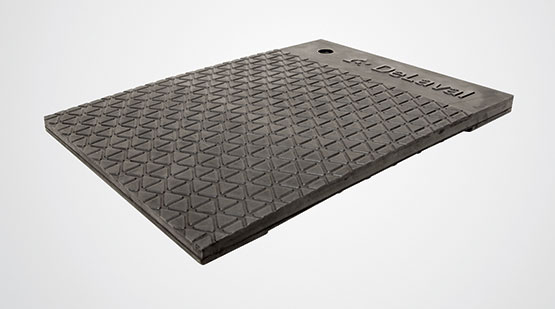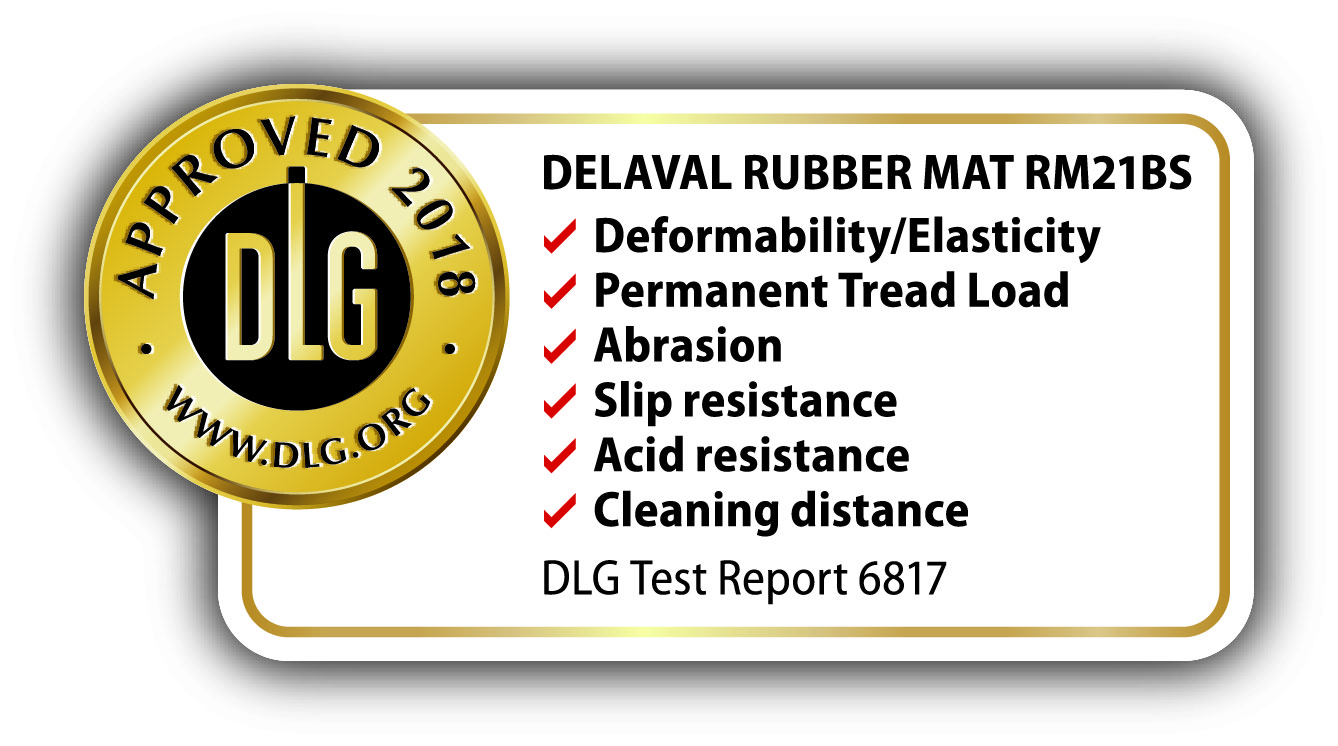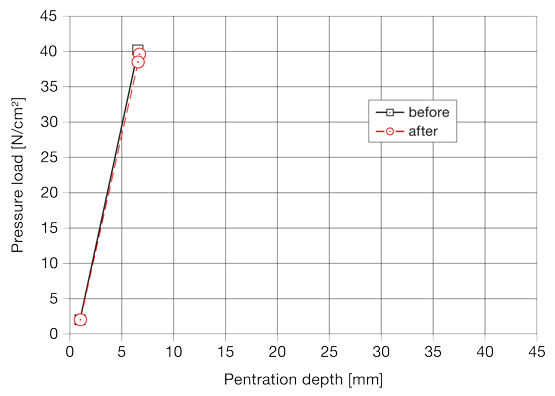DeLaval rubber mat RM21BS
DLG-APPROVED: "Deformability/Elasticity, Permanent Tread Load, Abrasion, Slip resistance, Acid resistance, Cleaning distance"
The approval
A quality mark “DLG-APPROVED for single value-determining criteria” is awarded to agricultural products which successfully passed a smaller-scope DLG usability test according to independent and recognized evaluation criteria. The test intends to highlight special innovations and key criteria of the test item. The test can focus on criteria from the DLG testing framework for full tests or on other individual features or qualitative criteria. The minimum requirements, the test conditions and procedures as well as the evaluation guidelines of the test results are determined in consultation with a DLG expert group. They comply with the generally recognized technology rules as well as with scientific and agricultural knowledge and requirements. The successful test concludes with the publishing of a test report and the awarding of a quality mark which is valid for five years following the award date.
The DLG-APPROVED Test “Deformability/Elasticity, Permanent Tread Load, Abrasion, Slip resistance, Cleaning distance” includes technical measurements on test benches of the DLG Test Center. The deformability and elasticity, the abrasion resistance, the slip resistance, the cleaning distance were measured and a permanent tread load was applied. The test was based on the DLG Testing Framework for elastic stable flooring, as of April 2015. Other criteria were not investigated.
Assessment – Brief Summary
The DeLaval rubber mat tested here, an elastic floor covering for the resting area in cubicle houses, was investigated with regard to durability and comfort properties on test stands in the DLG-APPROVED test for single value-determining criteria. The deformability and elasticity of the cubicle mat, the abrasion resistance, the slip resistance, the acid resistance, the cleaning distance were measured and a permanent tread load was applied.
Table 1: Overview of results
| Test characteristic | Test result | Evaluation * |
| Deformability and elasticity | ||
| – in new condition | 6.6, satisfactory | ◯ |
| – following endurance test | 6.7, satisfactory | ◯ |
| Permanent tread load | ||
| no lasting deformation | + + | |
| no noticeable wear | + | |
| Abrasion test | ||
| satisfactory resistance | ◯ | |
| Slip resistance ** | ||
| good slip resistance on dry and wet mat surface | + | |
| Cleaning distance | ||
| 20 cm with flat jet nozzle | ◯ | |
| 40 cm with flat jet nozzle | ◯ | |
| Acid resistance* | ||
| Feed acid mixture | resistant | + |
| Uric acid | resistant | + |
| Sulfurous acid | resistant | + |
| Ammonia solution | resistant | + |
| Disinfection liquid | resistant | |
| Peracetic acid | resistant |
The Method
Deformability and elasticity
The deformability is measured in new condition and following permanent tread load using ball penetration tests with a calotte (r = 120 mm) and a penetration force of 2,000 N (corresponding to approx. 200 kg).
Permanent tread load
The permanent tread load is measured on a test stand with a round steel foot in the standard test programme with 100,000 alternating loads at 10,000 N (corresponding to approx. 1,000 kg). The steel foot is adapted to the natural conditions as an “artificial cow foot”. The foot has a diameter of 105 mm and therefore a contact area of 75 cm²; the carrying edge of the hoof is simulated by a 5 mm wide ring on the periphery of the sole that projects 1 mm above the rest of the surface.
Abrasion test
In a standardised abrasion test with 10,000 cycles the top cover was grinded with an emery cloth (granulation 280) and a grinding pressure of 500 N (= 8.13 N/cm² surface pressure). The friction element was cooled continuously with water to prevent an influence of the generated heat during the abrasion test. The size of the grinded area was 61.5 cm².
Slip resistance
The measurements were carried out with the Comfort Control test rig of the DLG Test Center. A loaded (10 kg) round plastic foot (105 mm diameter, with a contact area of 75 cm², 3 mm wide ring at the periphery of the ground) was pulled with a velocity of 20 mm/s across the mat.
Acid resistance
A permanent dipping test in accordance to DIN EN ISO 175:2000 (performance of synthetic material against liquid chemicals) was carried out. Test samples (size 30 mm x 30 mm) were completely dipped into different test liquids for 24 hours and 28 days (room temperature 20° Celsius). In the 28 days test the liquids were changed weekly.
After the 28 days the samples were washed with distillate water and dried for 24 hours. Before and after the dipping the weight, the dimensions and the shore hardness (shore A) of the test samples were measured. Additional visual evaluation was done for alterations like colour changing, swelling, destruction or crystallisation.
All samples were evaluated in comparison to the standard water.
Cleaning distance
In test bench trials with a high pressure cleaner (approximately 145 bar, exposure period 1 minute with a 25° flat jet nozzle and a coarse dirt remover) the distance was measured where no damage occurs.
The Test Results in Detail
Deformability and elasticity
In the ball penetration tests in new condition with a calotte (r = 120 mm), penetration depth was 6.6 mm. The resulting calculated bearing pressure of 40.2 N/cm² indicates a satisfactory load on the carpal joints when lying down and getting up.
Elasticity was measured following a permanent tread load exerted by a steel foot (contact area: 75 cm²) with 100,000 alternating loads at 10,000 N. Following the endurance test, the penetration depth of the calotte increased from 6.6 mm to 6.7 mm. The bearing pressure decreased from 40.2 N/cm² to 39.6 N/cm² (see Fig. 2). This means that deformability and elasticity slightly increase.
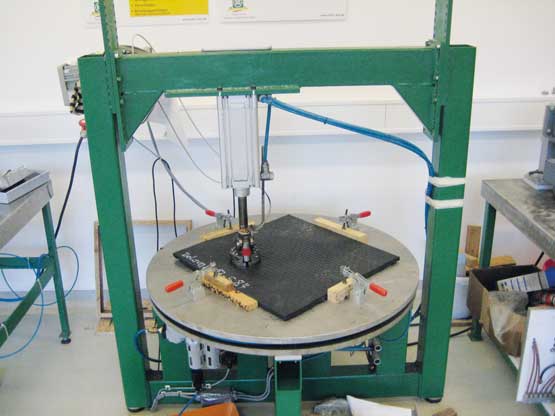
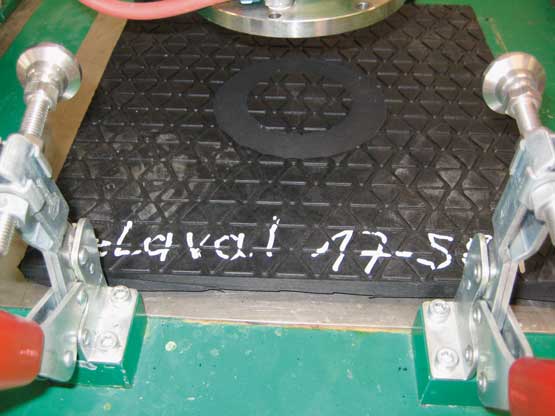
Permanent tread load
After the Transition Mat had been exposed to a permanent tread load exerted with 250,000 alternating loads of 5,000 N (corresponding to approx. 500 kg), the mat showed no noticeable wear. Lasting deformation could not be observed.
Abrasion test
The abrasion depth after 10,000 cycles amounted to 3.7 mm, this corresponds to approximately 18.5 % of the mat thickness. From the ground surface 24.4 grams were rubbed off. The abrasion depth and the slight grit implicate a satisfactory wear resistance of the rubber mat.
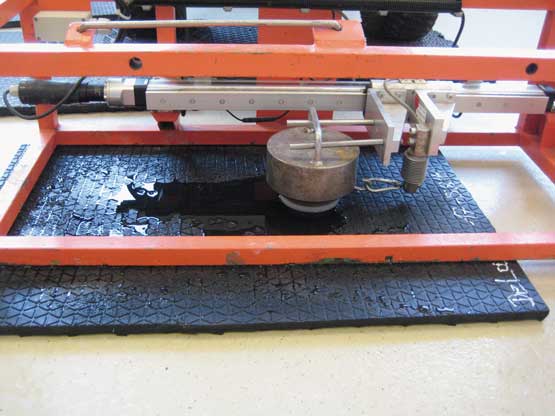
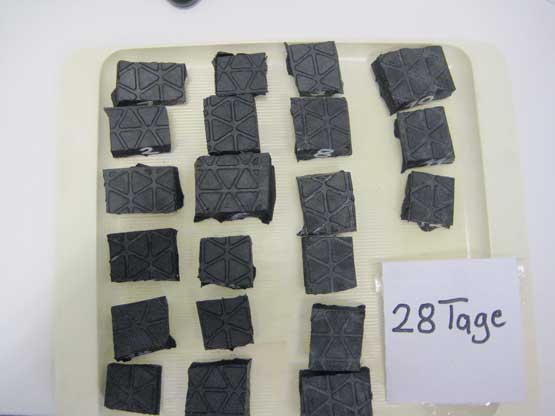
Slip resistance
The slide pulling tests showed a good slip resistance on the dry or wet mat surface in new condition. The measured friction coefficients (μ) all surpassed the minimal value of μ = 0.45 which speaks for a good foothold.
Cleaning distance
In test bench trials with a high pressure cleaner damage to the mat only occurred when a minimum distance of 40 cm (with a coarse dirt remover) and 20 cm (with a flat jet nozzle) was not kept. For cleaning and disinfection of the floor cover only the cleaning agents permitted by the manufacturer should be used.
Acid resistance
The rubber mat was resistant against the used test liquids. The differences in weight, thickness and Shore A hardness between the acid treated and not acid treated samples were minor and lay in the range of water as standard. Against the used liquids the rubber mat seems to be good suited for the described use.
Table 2: Test liquids and results acid resistance
| Test liquid | Concentration |
Result after 24 hours residence time |
Result after 25 hours residence time | Evaluation |
| Feed acid mixture | ||||
| concentrate, pH 2 | no changing | no changing | resistant | |
| Excrement acids | ||||
| Uric acid | saturated urea solution (0,4 %) | no changing | no changing | resistant |
| Sulfurous acid | 5-6 % SO2 | no changing | no changing | resistant |
| Ammonia solution | 32 % solution | no changing | no changing | resistant |
| Disinfection liquid | ||||
| Barn Disinfection liquid | 2 %-solution of a product with | |||
| formic acid and glyoxyl acid | no changing | no changing | resistant | |
| Peracetic acid | 3000 ppm | no changing | no changing | resistant |
Summary
Based on test-stand investigations, the criteria tested in this DLG-APPROVED test for single value-determining criteria evaluate the comfort and durability properties of the DeLaval rubber mat RM21BS for use in the resting area of high cubicles in cubicle houses. The tested DeLaval rubber mat RM21BS met the requirements of the Testing Framework with respect to the investigated criteria.
Applicant and Test implementation
Manufacturer and Applicant
DeLaval International AB site Glinde,
P.O. Box 1136,
DE-21509 Glinde/Germany
Contact
Phone ++49 (0)403033443-39
Fax ++49 (0)40 3033443-49
Elaine.Araujo@delaval.com
www.delaval.com
http://www.delaval.com
Test implementation
DLG TestService GmbH, Gross-Umstadt location
The tests are conducted on behalf of DLG e.V.
DLG test scope
DLG-approved single criteria test
“Elastic Stable Flooring” (current as of 04/2016)
Department
Indoor operations
Head of Department
Dipl.-Ing. agr. Susanne Gäckler
Test engineer(s)
Dr. Harald Reubold *
* Author
Contact
DLG TestService GmbH - Groß-Umstadt location • Max-Eyth-Weg 1 64823 Groß-Umstadt Germany • Tel.: +49(0)69 24 788-611 • tech@DLG.org

